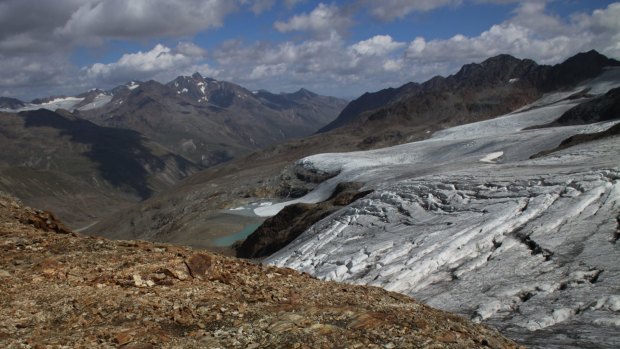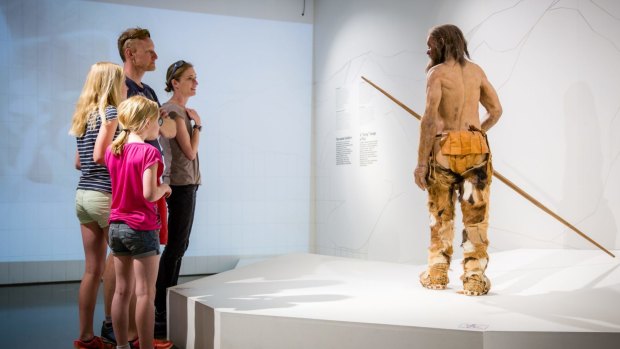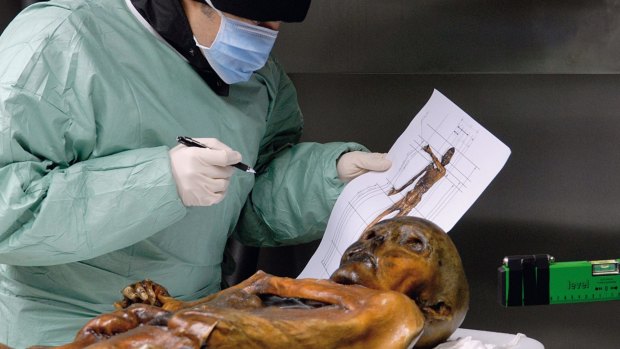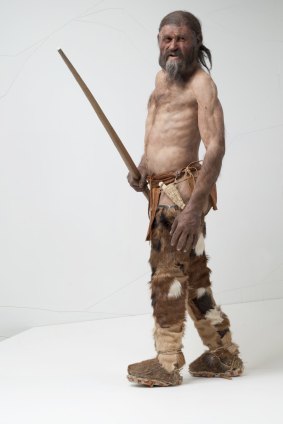This was published 4 years ago
Otzi the iceman, South Tirol Museum of Archaeology: Mystery of the world's best preserved mummy
By Andrew Bain

A Similaun glacier. Hikers found Otzi's body inside a glacier beside the Italian-Austrian border in 1991.
It's a criminal cold case that remains unsolved after 5300 years, even though thousands of people view the body every day, and new clues continue to emerge.
The body is that of an Alpine villager, perhaps even a chief, living in a time before the existence of Stonehenge and the Giza pyramids. His name is Otzi and he is the world's most perfectly preserved mummy.
Hikers found Otzi's body inside a glacier beside the Italian-Austrian border in 1991. Calculations showed that the body was 92 metres inside Italy, so after initially being taken to Innsbruck in Austria, it was later transferred to the northern Italian city of Bolzano, where today it rests inside the South Tirol Museum of Archaeology. The museum's name might sound as dry as an Italian summer, but this is one of Europe's most fascinating historical displays.

Crowds are queuing up to see the story of Otzi the Iceman.Credit: South Tirol Museum of Archaeology
In death, Otzi has achieved fame and popularity beyond anything a 50-year-old Copper Age villager from the valleys around Bolzano could have imagined in life.
At the entrance to the museum, which is devoted entirely to Otzi's story, queues snake around the street corner. Inside, the collection is spread over four levels, though the focus for visitors is the first floor, where Otzi's body is kept in cold storage behind a small window.
I've come to the museum after a week of hiking in the Alps with tour company Hedonistic Hiking, getting to know the mountains and now, fittingly, about to get to know the oldest man known to have set foot in them.

Ozti is one of the world's best-preserved mummies.Credit: South Tyrol Museum of Archaeology
Inside the museum, we're met by guide Nico, who promises a journey through a prehistoric murder mystery. Though we view the body first, it's better to leave this moment until you've toured the rest of the collection, gathering together the clues and the knowledge that will guide your eye when you see the body – there's a lot more to this mummy than preserved flesh.
The collection of artefacts displayed on the first floor is extensive. Though Otzi weighed just 50 kilograms and was an old man, by the life expectancy norms of 3000BC, complete with osteoporosis and a parasite-borne sickness, he was carrying more than 30 kilograms of equipment and clothing.
Found around him in the glacier were goatskin leggings, a bearskin cap, a longbow, arrows, and even maple leaves he would have used to wrap around live embers as he walked each day.

A recreation of Ozti.Credit: South Tirol Museum of Archaeology
The most important artefact is Otzi's perfectly moulded copper axe, displayed in a glass cabinet in the middle of the collection. The discovery of this axe rewrote European history, setting back the date of the Copper Age by 1000 years.
"The axe suggests Otzi was a powerful man, maybe even a chief," Nico says. "It's like comparing a Ferrari and a Fiat 500. Both will get you where you want to go, but in different style. Why have a copper axe when a flint one will do the same thing, unless you're a man of power?"
The artefacts, combined with almost 30 years of research, have helped to unravel the story of Otzi's final days. Only the assailants remain unknown. The evidence – a healing knife wound in Otzi's right hand, arrows without arrowheads, an undigested meal of ibex meat in his stomach – points to a man fleeing across the Alps without time to properly prepare for the journey. When he stopped to rest and eat, he was attacked.
An arrowhead lodged in Otzi's left shoulder and a fractured eye socket tell of a violent death, shot by an arrow and then bashed over the head.
On viewing Otzi's body, which is kept at a constant temperature of minus six degrees, the story becomes reality. Most striking is the honey-coloured body's remarkable preservation, including the presence of 61 tattoos that are believed to be an early example of acupuncture.
The cut in the hand is visible, and the position of the body – left arm draped across his chest, right arm outstretched – suggests the killers turned it over to try to retrieve the arrowhead.
Was Otzi the good man wronged? The bad guy avenged? It's all part of the intrigue at this museum of prehistoric CSI.
TRIP NOTES
Andrew Bain travelled courtesy of Hedonistic Hiking.
MORE
FLY
Emirates flies daily from Melbourne and Sydney to Milan. Bolzano is around three hours by train from Milan. See emirates.com; italiarail.com
VISIT
The South Tirol Museum of Archaeology is open Tuesday to Sunday. Hedonistic Hiking's nine-day Austria and the Dolomites trip includes a morning at the museum with a guided tour. See iceman.it; hedonistichiking.com
Sign up for the Traveller Deals newsletter
Get exclusive travel deals delivered straight to your inbox. Sign up now.